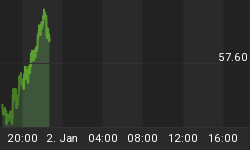Stanley Druckenmiller, the justly renowned investor, spoke at the Delivering Alpha conference on Wednesday, July 16, 2014. Quoting Druckenmiller: "As a macro investor, my job for 30 years was to anticipate changes in the economic trends that were not expected by others - and therefore not yet reflected in securities prices. I certainly made my share of mistakes over the years, but I was fortunate enough to make outsized gains a number of times when we had different views from various central banks."
Druckenmiller went on to discuss, among much else that deserves reading, how the Fed's emergency 1.0% fed funds rate in 2003-2004 defied conditions observed by him and his colleagues at Duquesne Capital. Where was the emergency? In short: "[W]e were confident the Fed was making a mistake, but we were much less confident in how it would manifest itself. However, our assessment by mid-2005 that the Fed was fueling an unsustainable housing Bubble, with dire repercussions for the greater economy, allowed our investors to profit handsomely as the financial crisis unfolded."
Today, Federal Reserve Chairman Janet Yellen sounds more preposterous every time she opens her mouth. Last week, maybe it was two weeks ago, she offered America a sector analysis, proposing that small-cap and biotech stocks look overpriced. A few days later, ECB President Mario Draghi offered his opinion of no widespread asset bubbles, although some markets looked "frothy."
It has been less than a decade since Fed chairman Greenspan declared there was no housing bubble, though he saw signs of "froth." His weasel act warranted derision, which is just what it received, such as in the Economist's headline: "Frenzied Froth" (May 28, 2005). Draghi is acclaimed for his well-tailored suits but they stink of old mothballs. He's a botoxed Greenspan.
The two of them - that would be Yellen and Draghi - have decided to let markets take their course, now that the Fed and ECB have used every possible mechanism to create mispricings in all markets. They will administer regulatory measures, if necessary.
The only such declaration of any use would be to administer the two of them, along with their supercilious staffs, out of existence. Instead, the average person who reads newspapers that include even a moderate degree of financial reporting knows multiple crashes are building.
The all-star break results are in. That is, the announcements of how first-half 2014 security issues compare to earlier years. We can congratulate ourselves. Never before has the world shown such indulgence, intemperateness, and unconscionable underwriting as in 2014.
"Megadeals... helped push the number of debt sales by highly rated companies in the U.S. to record levels in the first half of the year. These companies sold about $642 billion of debt." That "outstrips the previous record set in 2009, when $612 billion of bonds was sold..." (Wall Street Journal, July 1, 2014) Aside from the probable default rate (where are you now, TXU?), megadeals are no friend to the workers.
"As investors scour the landscape for income, the first half of the year saw record amounts of new corporate bond issuance as well as record issuance of collateralized loan obligations. CLOs are securitized vehicles that invest in bank loans made to junk-rated companies, first pooling the loans and then dividing them into tranches to be sold to investors at varying levels of income and risk.... The $58 billion of CLO issuance in the first half of this year puts 2014 on pace to top $100 billion and break the previous single-year issuance record...set in 2007." (Wall Street Journal, July 2, 2014) Pension plans and insurance companies are large buyers of such attempts to increase yield; an attempt to reinstitute the yield confiscated by the same central banks that have now declared their forbearance in monitoring default-prone issues.
Doug Noland, manager of the Prudent Bear Fund, in his Credit Bubble Bulletin, written on July 11, 2014, analyzed the seven-year itch, under the appropriate title: "2014 vs. 2007":
"From my perspective, 2014 and 2007 share troubling similarities. Both periods feature overheated securities markets, replete with the rapid issuance of securities at inflated valuations. Both are characterized by investor exuberance in the face of deteriorating fundamentals - and in both cases central bank policymaking was fundamental to heavily distorted market risk perceptions. It's no coincidence that today's overheated backdrop - record securities issuance and meager risk premiums/record high prices - readily garner statistical comparison to 2007.
"This year's booming M&A market has posted the strongest activity since 2007. Second quarter global M&A volume of $1.06 trillion was up 72% from the year ago period. Here at home, M&A more than doubled year-on-year to $473 billion, pushing record first-half volume to $749 billion. The proliferation of deals was fueled by the loosest credit conditions in years. First-half global corporate bond issuance hit an all-time high $2.29 trillion. A record $286 billion of junk bonds were issued globally, as average junk yields traded to the lowest level ever. At $642 billion, first-half U.S. investment-grade company bond sales easily posted an all-time high. The first six months of 2014 also saw record issuance of collateralized loan obligations (CLOs). A record number of global IPOs were sold in the first half, with $90.6 billion of offerings 54% above comparable 2013. Led by technology and biotechnology issues, U.S. IPO sales enjoyed the strongest first-half since the height of the technology bubble back in 2000. According to Dealogic, year-to-date total global sales of corporate stock and equity-linked securities reached an unmatched $510 billion, outpacing 2007's record pace."
It is certain such frivolities are "not yet reflected in securities prices."
Frederick Sheehan writes a blog at www.aucontrarian.com

















